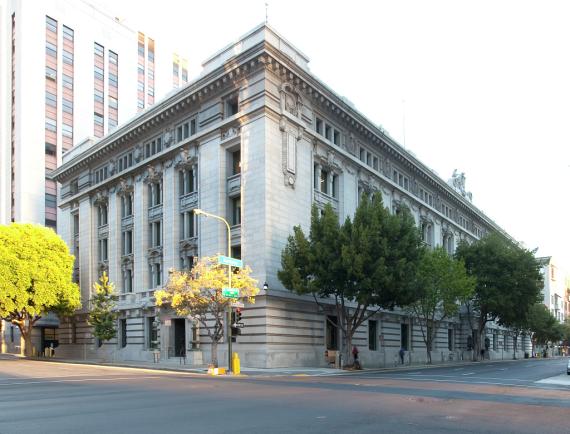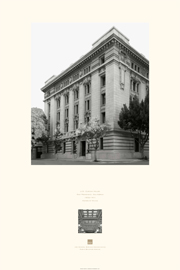Location: 555 Battery St, San Francisco, CA 94111
History
The first United States Congress established the U.S. Customs Service in 1789 to collect duties and taxes on imported goods, control carriers of imports and exports, and combat smuggling and revenue fraud. Until the federal income tax was created in 1913, customs funded virtually the entire government.
Possessing an extraordinary natural harbor and one of the country’s finest ports, San Francisco rapidly expanded during the nineteenth century. By the turn of the twentieth century, construction of the Panama Canal, which would dramatically shorten trade routes between the Atlantic and Pacific, had begun. City officials likely anticipated increased commerce and determined that a larger custom house was needed.
In 1905, Eames & Young, a St. Louis architectural firm, won a national design competition for a new custom house. The firm was chosen under the auspices of the Tarsney Act, which allowed the Treasury Department to hire private architects rather than use only government designers. William S. Eames and Thomas Crane Young were the principals of the prominent firm. They designed the building in the Beaux Arts Classicism style, which was popular as part of the City Beautiful movement that sought to create more appealing urban centers.
An earlier, more modest custom house, located on Battery Street between Jackson and Montgomery Streets, was demolished to make way for the present building. Ground was broken for the new custom house on January 28, 1906. Three months later, a devastating earthquake and subsequent fire decimated San Francisco. Because much of the city was being rebuilt simultaneously, there were severe labor and material shortages. As a result, construction of the custom house was not completed until 1911.
The U.S. Custom House was listed in the National Register of Historic Places in 1975. After the 1989 Loma Prieta Earthquake, seismic and other upgrades were made from 1993 to 1997. While the building continues to serve many of its original purposes, the U.S. Customs Service is now the U.S. Customs and Border Protection, part of the Department of Homeland Security.
Architecture
The U.S. Custom House is an excellent example of the Beaux Arts Classicism style of architecture, which is characterized by classical yet exuberant details. Many important federal buildings were designed in this style during the late nineteenth century and early twentieth century. Some elements of Beaux Arts Classicism that are found on the U.S. Custom House include a symmetrical facade and articulated entrances highlighted with granite entablatures and carvings. The main entrance on Battery Street has a grouping of sculptural figures over the cornice.
The imposing six-story building is faced in pale granite from Raymond, California. The concrete foundation of the building rests on timbers from the hull of the steamship Georgian, a vessel from San Francisco’s gold rush days that was abandoned. The building essentially has a U-shaped plan that surrounds an oval, two-story pavilion that contains the former postal space and custom hall.
Like many buildings with Beaux Arts Classicism features, the facade is divided into three horizontal zones. The lower zone is a rusticated granite base with deeply recessed joints that extends across the first story. The middle zone is characterized by smooth granite with windows topped with pediments and cartouches. The upper zone is a recessed fifth story, where stylized eagle motifs separate the windows, and parapet.
The interior of the U.S. Custom House contains a variety of high-quality finishes. Oak parquet floors are set in a herringbone pattern. Walls are paneled in oak with applied carved ornaments and inset with panels of green leather and decorated canvas. Other floors and walls are covered with marble. Ceilings are decorated with elaborate molded and painted plaster. The central lobby contains marble stairs and flooring, and a high ceiling with decorative plaster work.
The monumental custom hall originally functioned as the most important operational and public space. The rich finishes include a marble floor and applied plaster ornamentation such as pilasters. The walls and vaulted ceiling of the custom hall are finished with plaster and painted with a vibrant color scheme. Three historic skylights were restored to their original appearance as part of a renovation and restoration in 1997. Large, arched windows dominate the space. The curved end walls of the room incorporate two large murals painted in 1915 by Abraham Lincoln Cooper, who also painted murals at the U.S. Courthouse and Post Office in Columbus, Ohio. Building the Panama Canal commemorates the completion of the canal in 1915, and Allegory of San Francisco is a representation of the port city. The paintings were restored in 1938 and 1971.
Another significant interior space is the port director’s office on the third floor. Originally used as an office suite by the collector of customs, the rooms have undergone only minor changes. Walls are paneled in oak with an ornamental frieze and a patterned cornice. The rooms contain stained oak parquet floors and a marble fireplace. The office was used as a set in the movie The Right Stuff in 1983.
Offices throughout the building retain historic finishes, including wood coat and sink cabinets. Relatively few changes have been made to the building since its construction. In 1997, a renovation that increased seismic resistance and upgraded electrical, plumbing, and data systems was completed. Original historic finishes were restored as part of the project.
Significant Events
- 1905: Design competition won by Eames & Young
- 1906: Ground broken for construction; Great Earthquake and Fire destroy much of San Francisco
- 1911: Construction completed
- 1975: U.S. Custom House listed in the National Register of Historic Places
- 1989: Loma Prieta Earthquake
- 1997: Renovation completed
Facts
- Architect: Eames & Young
- Architectural Style: Beaux Arts Classicism
- Construction dates: 1906-1911
- GSA Building Number: CA0092AA
- National Register of Historic Places Landmark Status: Listed in the National Register of Historic Places
- Primary Material: Granite
- Prominent Features: Classical Facade; Custom Hall; Port Director’s Office
Poster Download
Download the poster [PDF - 213 KB]

 U.S. General Services Administration
U.S. General Services Administration

